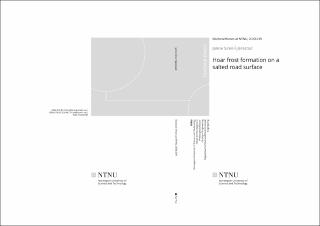| dc.contributor.advisor | Klein-Paste, Alex | |
| dc.contributor.advisor | Wåhlin, Johan | |
| dc.contributor.author | Fjærestad, Janne Siren | |
| dc.date.accessioned | 2020-08-17T12:20:33Z | |
| dc.date.available | 2020-08-17T12:20:33Z | |
| dc.date.issued | 2020 | |
| dc.identifier.isbn | 978-82-326-4827-6 | |
| dc.identifier.issn | 1503-8181 | |
| dc.identifier.uri | https://hdl.handle.net/11250/2672630 | |
| dc.description.abstract | Hoar frost formation may lead to slippery driving conditions during late autumn and winter time. Hoar frost formation occurs when humidity in the air deposits directly as ice on the cold road surface. To avoid slippery road during hoar frost situations, anti-icing chemicals are commonly used since they lower the freezing point of water. Unfortunately, the use of chemicals have negative impact on both cars, infrastructure and the environment surrounding the roads.
Their usage should therefore be reduces as much as possible, without raising the risk of accidents. The work of this thesis has been to investigate the process of hoar frost formation on salted road surface. A laboratory setup simulating hoar frost formation has beed developed as a part of this work. It consists of an open loop wind tunnel where warm humid air is forced to flow over a cold stone surface. The setup has shown to be able to simulate hoar frost conditions similar to those reported onsite with sufficient stability on critical parameters, such as temperatures and air humidity.
It is suggested to spilt the process of hoar formation on a salted road surface in two parts, the dilution process and the freezing process. The dilution process occurs from the solution is applied on the road surface until it is diluted to its freezing concentration at the road surface temperature. The time it takes is denoted as the dilution time. The freezing process occurs from the point the freezing concentration is reached until the ice formation results in slippery road conditions. The time it takes is denoted as the freezing time. The time froma chemical is applied on the road surface to the road becomes slippery is denoted the protection time, and it is the sum of the dilution time and the freezing time. Both parts of the process were studied.
The dilution process was studied for solutions ofNaCl, CaCl2 andMgCl2. The over all finding was that the presence of anti-icing chemical on the road surface did affect the rate of humidity transport. The presence of anti-icing chemicals did increase the rate up to 30% compared to a surface without chemicals, but the effect diminished during the first two hours as the solution got diluted.
The freezing process was examined for a solution of NaCl. The freezing process was found to start in the top layer of the solution, even though it is colder in the solution/stone interface. This indicates that there is was concentration gradient in the solution due to slower diffusion of water in the salt solution than in the air. A considerable amount of ice could be present on the salted road surface before the ice got strong enough to withstand the simulated mechanical load of traffic. For a film thickness of 0.06mmof 10% NaCl solution, the critical ice fraction was found to be 0.67. For higher ice fractions the ice was not removed by the pendulum. The critical ice fraction was found to depend on the amount of solution applied, and an ice fraction up to 0.81 was acceptable for an applied film thickness of 0.1 mm.
The increased mass flux due to the presence of chemicals contributes to a reduction in the protection time. Opposite, the critical ice fraction contributes to an extension in the protection time. Calculations have shown that by including the freezing period, the total protection time is more than 3 times longer than estimated when assuming that the protection time ends when the freezing concentration is reached. When including the increased mass flux in the dilution period, the total protection time is reduced by only 5-7% of the protection time calculated without the increased mass flux. | en_US |
| dc.language.iso | eng | en_US |
| dc.publisher | NTNU | en_US |
| dc.relation.ispartofseries | Doctoral theses at NTNU;2020:239 | |
| dc.relation.haspart | Paper 1:
Fjærestad, J. S., Wåhlin, J. and Klein-Paste, A. (2020). Journal of Cold Regions Engineering
Experimental Setup Simulating Hoarfrost Formation on Roadways
https://doi.org/10.1061/(ASCE)CR.1943-5495.0000207 | en_US |
| dc.relation.haspart | Paper 2:
Fjærestad, J. S., Wåhlin, J. and Klein-Paste, A.
The effect of anti-icing chemicals during hoar frost situations | en_US |
| dc.relation.haspart | Paper 3: Fjærestad, Janne Siren; Klein-Paste, Alex; Wåhlin, Johan. Chemical Frost Protection of Road Surfaces: A Laboratory Investigation. Transportation Research Record 2020 ;Volum 2674.(1) s. 228-235
https://doi.org/10.1177/0361198119900122 | en_US |
| dc.relation.haspart | Paper 4: Wåhlin, Johan; Fjærestad, Janne Siren; Kaj, Thomsen; Klein-Paste, Alex. Thermodynamics of deicing chemicals. TRB annual meeting 2017 | en_US |
| dc.title | Hoar frost formation on a salted road surface | en_US |
| dc.type | Doctoral thesis | en_US |
| dc.subject.nsi | VDP::Technology: 500::Environmental engineering: 610 | en_US |

